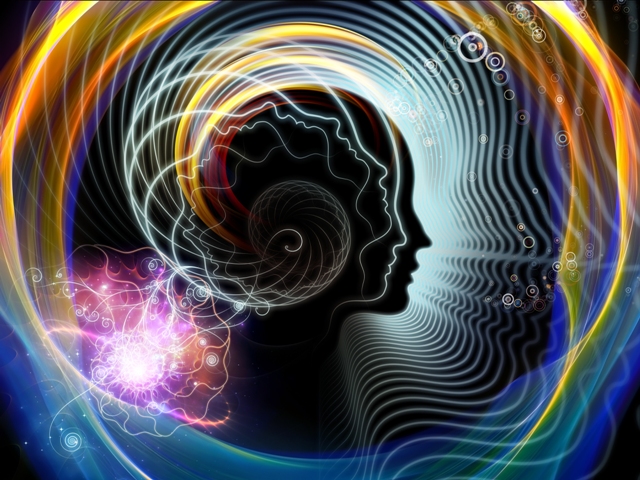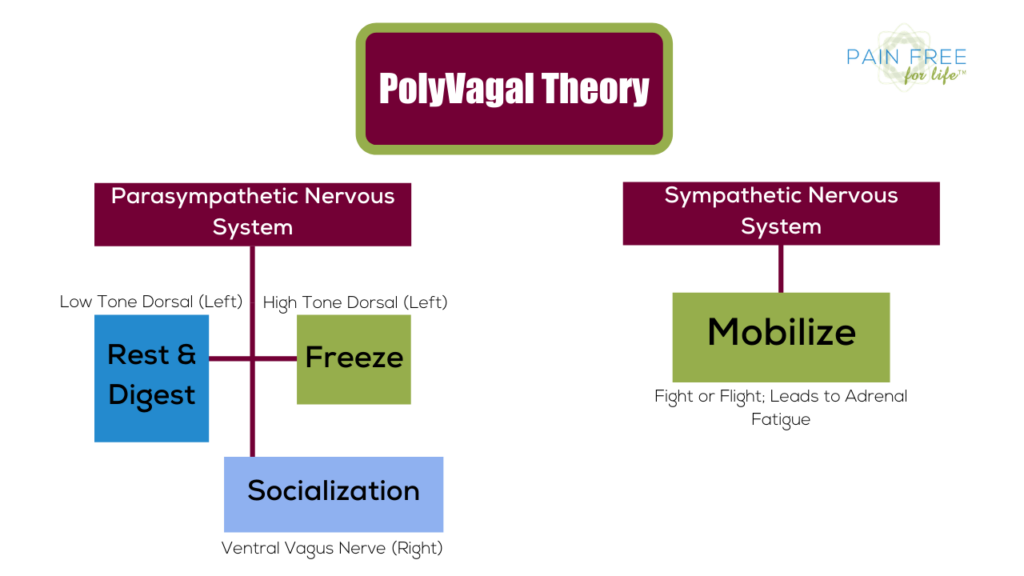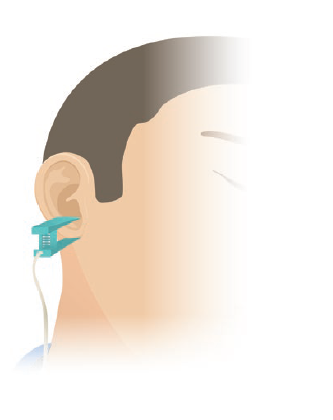
If you’re not healing from chronic pain or a debilitating health condition— no matter what you do—polyvagal theory may be the answer you’ve been looking for!
In this blog, we will introduce polyvagal theory, how it relates to vagus nerve stimulation, and present two ways in which you can safely stimulate the ventral vagus nerve through microcurrent therapy to effectively resolve chronic health conditions that other treatments can’t touch.
Vagus Nerve Stimulation
Learning about polyvagal theory starts with understanding the vagus nerve and how stimulating it can encourage rest, relaxation, restoration, and healing.
The vagus nerve is sometimes referred to as the “the wandering nerve” because it can be traced throughout most of your body, interacting with and connecting your organs. The vagus nerve controls your nervous system and is incredibly important to your health and wellbeing.
This image demonstrates how intertwined the vagus nerve is in your body:

Vagus nerve stimulation is at the heart of bioelectronics, a field of medicine that utilizes and applies electrical energy to address inflammation, chronic pain, and so much more!
There are two ways in which to utilize bioelectronics for healing:
- Implantation surgery (costly and invasive)
- Microcurrent therapy (affordable and non-invasive)
Conditions in which conventional medicine offers no cure or treatment have been known to respond positively to bioelectronic treatment. The life-changing implications are incredible!
In fact, vagus nerve stimulation is so powerful that it lies at the core of almost every inflammatory treatment protocol we have ever designed or conducted.
Thousands of our patients across the world have been able to successfully pull themselves out of chronic pain and start to take their lives back due to vagus nerve stimulation; because of this, we are continually researching the subject.
Recently, this research has made us look to polyvagal theory—and we’d like to share what we’ve learned! Firstly, let’s unpack the concepts behind this theory; then, we will discuss how it pertains to your healing.
Parasympathetic vs. Sympathetic State—What You Should Know
The vagus nerve controls your parasympathetic and sympathetic states. How does this work? It starts with your Autonomic Nervous System or ANS.
Your ANS drives all the involuntary processes in your body that are not under your conscious control, such as your blood pressure, heart rate, cell activity, digestion, respiration, and even body temperature.
There are two branches to your ANS. The first is the sympathetic nervous system, which works to put your body and brain into a “fight or flight” response in the face of danger. The second is the parasympathetic nervous system, which serves as the “brake pedal” and that initiates a relaxation response to restore reparative function.
Sympathetic State
As we previously mentioned, the sympathetic state is one of “fight or flight.” In this state, your body is focused on the short-term goal of avoiding danger.
Here’s an example of how the sympathetic state can work to your advantage in a survival situation:

Tyler is 13 and has found a new hobby of climbing the biggest trees he can find and posting videos from the top for his friends to see on social media. Tyler boldly climbs a colossal oak tree to reach the top and promptly reaches to pull out his cellphone from his pocket to take a video. While digging through his pocket, Tyler loses his balance and slips and falls—landing baldly on his arm, which causes a break. Not to mention, Tyler’s cell phone is now broken as well, making it impossible for him to call for help. This is where Tyler’s sympathetic mode engages, giving him an adrenaline boost. This boost of energy allows him to rush to the closest house and ask for them to call for medical assistance. Once Tyler arrives at the hospital, his body starts transitioning out of a sympathetic state into a parasympathetic state, allowing him to start to rest, repair, and heal.
How Living in a Constant Sympathetic State Hurts Your Health
Under normal circumstances, like Tyler’s, once the danger has passed the sympathetic nervous system disengages, and the body returns to a parasympathetic state where the body can rest, repair, and regenerate.
But unfortunately, this isn’t the case for people who suffer from chronic pain, autoimmune conditions, or emotional trauma, who all tend to live in a constant state of fight or flight mode. Living this way can cause further health problems and will block your body’s ability to heal. How?
Think of your adrenal glands as the battery power that helps you survive a traumatizing event or injury. Living in a sympathetic state, whether it be due to physical or mental trauma, can cause adrenal burnout as your body becomes incapable of climbing out of chronic adrenal fatigue. Living in a state of chronic adrenal fatigue leaves you tired, weak, and unable to enjoy life.
Parasympathetic State
Digestion, detoxification, and immune function are only able to take place when your body is in a parasympathetic state. The bottom line: when stress is on (sympathetic state), your capacity for healing is turned off.
Our goal in stimulating the vagus nerve through microcurrent therapy is to encourage your body to exit sympathetic mode (fight or flight) and achieve a parasympathetic mode (rest and repair).
Now you may be wondering what this has to do with polyvagal theory?
Enter Polyvagal Theory

Recently, we got to thinking, “what do vagus nerve stimulation and polyvagal theory have in common?” and what we learned was illuminating! But, before we delve into the critical role polyvagal theory plays in healing, we would like to explain the basis of this theory to you.
Simply put, “poly” means many, and “vagal” refers to the vagus nerve. In polyvagal theory, we are looking at the many branches of the vagus nerve.
The main crux of polyvagal theory is: If you socialize after trauma, whether it be physical or mental, you can move past it and heal. If you go into a “freeze” state and refuse to talk about or relive your trauma, you will be stuck and unable to heal. This frozen state is known as having a high tone dorsal vagus nerve.
By breaking through this freeze state (by stimulating the vagus nerve) you can return to a parasympathetic nervous state or low tone dorsal vagus nerve and achieve homeostasis.
How We Apply Polyvagal Theory to Microcurrent Therapy for Profound Healing
There two ways in which we “hack” the vagus nerve through microcurrent therapy to promote healing.
- Vagus Nerve Stimulation—Stimulating the ventral (right side) vagus nerve at 7-12 Hz frequency with your microcurrent device is an effective and preferred approach.
It is theorized that the ventral vagus nerve affects the middle ear, which filters out background noise and makes it easier to hear the human voice. It also affects facial muscles and the ability to communicate with facial expressions.
The main point here is that the ventral vagus nerve activates when we are having a conversation or socializing. It doesn’t activate if we don’t socialize. As we previously mentioned, it is essential to get out of “freeze mode” by activating this area of your brain when healing from trauma.
It’s crucial to note that every physical pain will come paired with emotional stress or trauma. You need to address this emotional trauma by stimulating the ventral vagus nerve to address the physical pain.
If you feel that stimulating this side may not be doing the trick, you may need to turn pull yourself into hard fight or flight in order to enable your body to be pulled out of it. The concept of Triggering Beta below follows this principle.
Rob Vanbergen, HHP, BSc.
- Trigger Beta (fight or flight mode)—We are much more careful when recommending this treatment as it requires bringing your body into fight or flight mode. If you’re already living with adrenal fatigue, this treatment may not be the right answer for you.
Attach the ear clips and set them to Beta with your Avazzia Device. You will run this frequency for roughly 10-15 minutes then disconnect the ear clips. If your device doesn’t have beta mode, you can set it to FM RSI frequencies, which are quite similar.

You then follow this up IMMEDIATELY with Vagus Nerve Stimulation on the right side, and then treat the left side in the same way.
In this treatment, you bring yourself into fight or flight then stimulate the vagus nerve to bring yourself back down. With this taken care of, we have potentially removed a healing blockage and should start again with our daily Dorsal (left side) Vagus Nerve treatments.
This will keep the Dorsal nerve in a “low-tone” state of rest and repair.
This treatment mimics what your brain goes through when you socialize and discuss your trauma. The goal is to stimulate the nerves and turn off inflammation so you can move past the socialization aspect of polyvagal theory and move toward resolution.
Tap into Vagus Nerve Healing with Polyvagal Theory Today
The bottom line is: you can use vagus nerve stimulation via microcurrent therapy to put polyvagal theory into practice. Utilizing brain science for healing is powerful, but until polyvagal theory, many practitioners didn’t have a clear picture of how to use this information.
Thanks to polyvagal theory’s clarification of the role of the ventral branch of the vagus nerve, the opportunities for using this information to promote healing are endless!
For guidance on how to apply polyvagal theory to your healing regimen, we recommend our private membership program and online training.





